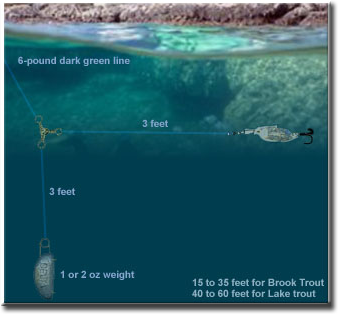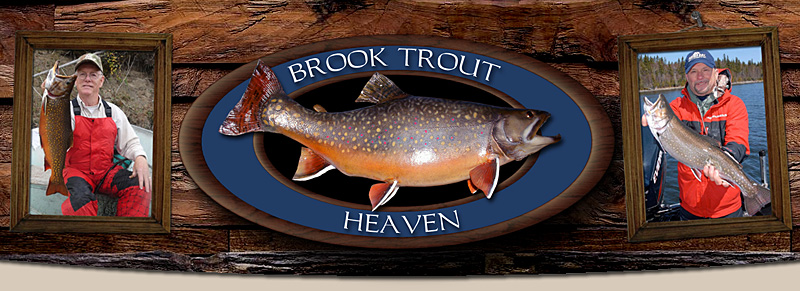Deep Water Light Tackle Brook Trout Tips Techniques
Before starting my web design company, I was a professional fishing guide working for some of the top fly-in fishing lodges in Canada. When you are a fishing guide, there is a lot of stress because your customers have to catch fish. You have to do what's right all the time. Below is how I kept my customers happy.
The 3-way swivel technique below is ten times better then using steel line or bait-walkers and is way more fun than boring downriggers. First, you can use light equipment, second, it's a lot more fun and last, you will catch tens times as many trout.
You need a light action rod with 6-pound test line. You also need a three-way swivels and a 1 or 2-oz weight depending how deep you want to fish. Brook Trout generally are shallower then Lake Trout so a 1-oz weight is good to start with. Go to 2-oz if your boat trolls a little fast.
 Diagram showing the setup:
Diagram showing the setup:
By using light line, the line has less friction with the water and slices through so that your line goes down to the bottom without having lots of line out. Tie two 3-foot pieces of line to your three-way swivel. Use a 1 or 2-oz. weight on one line and a light lure on the other. Brook Trout like small lures. Use #1 or #0 Mepps, Panther Martins or Blue Foxes. Small Cleos or a small Mepps Cyclopes are also good. If you are on a lake that you know has bigger Brookies over 2 pounds then the best lures to use are the Sutton Silver Spoon or the MooseLook Spoon.
Trolling Slow:
You only want to move just fast enough for your lure to work and no faster. If your boat is moving too fast, it will be very hard to find the bottom of the lake. If you are using a boat with a bigger motor and it's hard to keep slow, try back trolling. If your motor is bigger than 25hp than even back-trolling will be too fast unless going against the wind. With bigger motors you will need an electric trolling motor.
Finding the bottom:
The most important aspect of deep water trout fishing is letting out line to get to the bottom. DO NOT JUST LET YOUR LINE OUT UNTIL IT HITS BOTTOM. Hold the rod in one hand with the bail open. Let the line run through the palm of your other hand and grip the line. Once the boat starts moving and you have a good straight troll going, open your hand with the line then close it again. This way you can let out a foot or two of line at a time. Get a rhythm going. Open, close, open, close. Your rod tip will bounce up and down as you release little bits of line at a time. The rhythm of your rod tip bouncing will be disrupted when your weight hits the bottom of the lake. When this happens, reel up a foot or two. The purpose of this procedure is to keep your 3-way swivel setup from getting tangled.
Weather:
In the summer time, Brook Trout hit best in the morning between first light and 10:30 AM. They will hit better if the surface of the water is dead calm and it's a clear sky with high pressure. Any other conditions will cause them to slow down. If it's early spring, the trout seem to feed in other parts of the day. In some lakes the trout feed aggressively before dark.
Structure and wind:
Take a close look at the structure of the shoreline and try to extend the elevation patterns into the lake. If you see a cliff, odds are the water is deep at its face. If you see a string of islands, odds are there is a shallow shoal that runs between them. Trout like drop-offs so you would want to troll parallel to the string of shoals and not over them.
When you drop your line to the bottom, count how many times you let out line. You can get a good estimate of the depth. For Brook Trout, try to stay in 20 to 35 feet of water and close to shore. For Lake Trout, go a little deeper. 40 to 60 feet of water is usually a good feeding depth. If you come across a spot and catch a trout, odds are there are more of them there.
The wind is very important when trout fishing. Traditionally for warm water fish like Walleye or Musky, you would fish on the side of the lake were the wind is blowing. The logic being that the fish follow the surface food that is being blown in. With trout it's the exact opposite. The wind also blows the warm surface water, which does not hold enough oxygen for the trout. Thus fish the side of the lake where the wind is coming from.
Depth:
In the Spring, the Brook Trout will be right up to the surface. As the water starts to warm up with the changing weather, the trout start to go deeper. Here is the approximate depth for different times of year. This is not true for all lakes. Some smaller spring fed lakes will have trout shallow all year.
· Just after ice-out --> Between 5 feet and the surface
· Mid Spring --> About 5 to 10 feet deep
· Late Spring --> About 10 to 20 feet deep
· Summer --> Summer is the tricky part. Lake Trout stay suspended in 53° thermal layers, which is usually around 55-feet deep. Brook Trout usually don't go deeper than 35 feet and will stay close to shore or natural springs. Brook Trout also feed on bait-fish, which they find suspended in the 25 to 35-foot range but they also come up to the surface in the evening to feed on the surface. Brook Trout seem to keep their distance from Lake Trout and are found in places where there is less Lake Trout activity.
In really cold lakes like Lake Superior, the Brook Trout swim right along the shore in the shallow water all year round. Many people call them Coasters.
Depth Finder:
It's good to have a depth finder so you can map the schools of bait-fish that are suspended. When you do come across a school, troll around the outside of the school. The Brook Trout and Lake Trout sit right underneath the school waiting for weak or injured fish to venture outside the school. Out in the middle of the lake, you will find these schools of bait-fish in the 20 to 60 foot range. It's different on most lakes but this is a good place to start.
This 3-way swivel method also works just as good for Lake Trout, Rainbow Trout (Steelhead) and Salmon. When we go for salmon on the Great Lakes, we go with 8-pound test line and a 3-oz weights. We catch 30 pound salmon on 8-pound test line and a medium Ugly Stick. Just keep your drag set right for the line you are using and don't horse the fish in. Am I right by saying the fight is all the fun. With light equipment, it just takes a little longer to bring in the fish.




 Diagram showing the setup:
Diagram showing the setup: